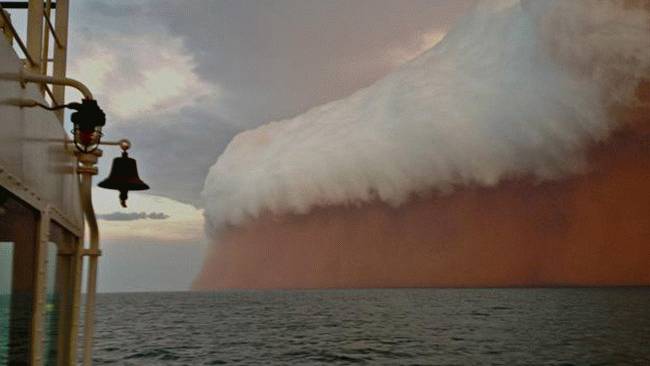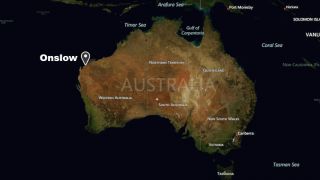In a scene that would not be out of place in almost any movie script that takes place on an alien planet, Australia’s weather has put on a display that raises eyebrows even in meteorological circles.
According to The Weather Channel website
Western Australians witnessed a freakish dust storm off the coast of Onslow on Wednesday.
The stunning views were created as wind and rain caused the storm to dump the sand and dust it had ingested while passing Onslow, Bureau of Meteorology duty forecaster Austen Watkins told Australian Yahoo!.
He said storm gusts reached 75 mph about 7:30 p.m. Wednesday and that such storms were normal for this time of year. Tug boat worker Brett Martin, who took some photos of the storm displayed above, told Yahoo! that he and his colleagues were west of False Island when the thunderstorm, which quickly strengthened and gathered dust, passed over Onslow and headed to the Indian Ocean.
“We were steaming along in the boat just before sunset and the storm was casually building in the distance, then it got faster and faster and it went from glass to about 40 knots in two minutes,” he said.
According to Perth Weather Live, the dust storm was not related to Tropical Cyclone Narelle, which was a couple hundred miles north of the dust storm location. Jonathan Erdman, meteorologist for The Weather Channel, was amazed by the images created by the Australian dust storm.
“In 18 years of meteorology, I’ve never seen a white shelf cloud capping the brownish dirt from the haboob. If there was a hall of fame for weather photos, this one would get in on the first ballot.”
Dust storms, or haboobs, are common in the U.S. Desert Southwest in the summer months. Thunderstorms form over higher terrain, but the dry air in the lowest layers of the atmosphere evaporates precipitation falling out of the thunderstorm, leading to strong winds at the surface, surging outward, picking up dust, instead of rain with a typical thunderstorm.
Australia’s searing heat has made news this week. According to Weather Underground’s Christopher Burt, Leonora topped out at 120 degrees Jan. 9, breaking that city’s all-time record.
Seriously, they call it a Haboob!
Actually an Arabic term for dense dust storms common to those regions, but these types of storms also occur in Australia and the south western United States. Australia has been experiencing newer and newer records in increasing heat waves for over a decade now.
[email protected]
Haboob






